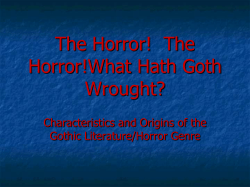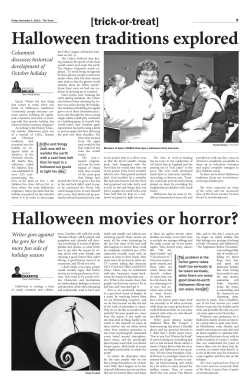
The Horror Genre - An Overview
The Horror Genre - An Overview ORIGINS: • THE HORROR STORY IN LITERATURE arose from Gothic tradition in literature dating from the 18th and 19th Centuries: tales of terror and often repressed sexuality in historical setting of dark, brooding menace. • Described at the time as Romantic literature, Mary Shelly’s Frankenstein and Bram Stoker’s Dracula are the most enduring, but the Werewolf and the Mummy can also be traced back to novels from this period. • Film versions of these stories have been remade many times from Universal in 1930s, to Hammer in 1950s and 60s to recent versions by Coppola and Kenneth Branagh and Stephen Sommers’ ‘Van Helsing’. • The American Gothic tradition derives from the work of Edgar Allan Poe and H.P. Lovecraft. Roger Corman made several films in the 1960s based on Poe’s novels. • THE FURTHER INPUT OF TWO EUROPEAN ARTISTIC MOVEMENTS COMBINED TO CREATE THE CLASSIC HORROR FILM OF THE 1930S: • Expressionism • Surrealism • German expressionism was an artistic movement of the early 20th Century that was characteristic of much architecture, painting and theatre in Germany during this period. German theatre in particular featured low key shafts of light, sets that were off-kilter, often without right angles or with exaggerated perspectives, black and white make up. • The idea of expressionism was to express emotions rather than external reality by projecting a character’s state of mind onto his environment. German expressionism is recognisable by its use of symbolism and by its use of exaggeration and distortion. • In the 1930s films by Universal Studios, expressionism is evident in the use of shadows and low tilted camera angles and camera movements, and high-ceiling sets. German and Austrian emigres working for Universal brought movement over with them to the United States. • Key names from this movement in horror are Karl Freund and James Whale. Freund was a German cameraman and later director who had worked with Murnau (amongst others) before moving to the States for a contract with Universal. James Whale was a British stage director who likewise went over to the States • Surrealism The art movement concerned with representing the unconscious and dreams. Surrealism drew on psychologist Sigmund Freud’s ideas on sexuality and The Uncanny. This is represented in the horror film by the flow of disturbing imagery and the presence of a ‘monster’ which externalises our personal and group fears. CLASSIC THEMES OR NARRATIVE CONVENTIONS • In his book ‘Dark Dreams’, Charles Derry charted the emergence of three distinct sub-genres in the decades following Psycho (1960), but has traced their historical predecessors in the ‘classic’ horror movie and other genres Hauntings and Demonic Possessions • These films play on our fear of the unknown, superstition and the idea that evil forces exist in the world. These forces can remain spiritual presences (Don’t Look Now) or can take the guise of witches (Blair Witch Project), ghosts (The Haunting) or demons (The Exorcist). • The characters fall prey to an evil force that is trying to victimise them in some way. The evil entity is doing this perhaps to gain vengeance eg in Blair Witch the witch is taking vengeance on the characters for trying to expose her. • In Nightmare on Elm Street Freddie is taking revenge on the people who killed him by haunting the dreams of their children and stalking them in their dreams. In many haunted house stories the ghost simply resents the presence of the people who have just moved in. • Sometimes the evil force wants to corrupt its victims - to make them do evil. Eg ‘The Shining’. • In this case the evil force wants to take control of its victim - take over his body or his mind or soul. Vampires and werewolves turn you into one of their own kind. • Often at the heart of these stories is the fight between good and evil in the Christian sense- temptation and sin. So there is usually a counterpart to the evil force - a symbol of good. Eg Dracula’s counterpart is Van Helsing. In the Exorcist, the Catholic priests fight the Devil for the soul of the girl • Witches, vampires and demons have their roots in folklore. Before modern medicine many disorders, blood diseases and psychological illnesses were attributed to supernatural causes: eg, epilepsy was thought to be caused by possession by demons. So these mythologies are in our ‘collective unconscious’ and are bought to the surface by horror films. Apocalypse • In this subgenre mankind is threatened with extinction by inhuman creatures that rise up and take over the world. Sometimes the threat comes from outer space (Day of The Triffids, War of The Worlds). Sometimes the threat is a plague or virus that threatens to wipe out mankind. (Dawn of the Dead, The Crazies). David Cronenberg’s film Rabid depicts an outbreak of rabies in Montreal. The film was very successful in Britain where rabies was, at that time (1977), a national phobia. • Sometimes the threat comes from the everyday traditionally harmless creatures with whom we share the planet. All at once these creatures decide to gather together against us and take over the world. The most famous film of this type is Hitchcock’s The Birds. • In the seventies there was a whole spawn of films featuring all types of creatures: rats (Willard), bees, worms (Squirm), ants (Phase 4) even giant rabbits (Night of the Lepus). • The films have a set structure: there’s a sudden proliferation of these creatures as if from nowhere and they descend upon a group of survivors who have barricaded themselves in a house. Usually the story ends with the people dying and the creatures winning out. • A characteristic of these films is that there is often no explicit reason for the creatures suddenly rising up against us. But there is a subtext there to do with fears of ecological unbalance, or a sense of revolution with the new order usurping the old. The Human Monster • Generally dates from Psycho (1960). Deals with horror of the personality: psychopathology and murder (the serial killer) or psychosis and insanity. So the audience is taken inside the mind of a killer (Henry: Portrait of a Serial Killer) or of a person who appears to be going insane (Repulsion, Jacob’s Ladder) • The ‘monster in the human’ (eg, Jekyll and Hyde) deals with mankind’ s propensity for evil. Often children are the subject (The Bad Seed, Apt Pupil). The idea that some people are born bad, with no sense of morality. • The ‘human in the monster’ (eg Frankenstein’s monster) deals with the sympathetic monster. We can feel some kind of understanding for these monsters because of their loneliness. They did not want to be created and are vilified by normal society. ICONOGRAPHY OF THE HORROR FILM Symbolic images which recur throughout the history of the horror film include: The haunted house (forbidden chamber) Symbols of death The disfigured face or mask The screaming victim (in modern horror the ‘final girl’) The phallic murder weapon: knife, stake, chainsaw. Binary oppositions of good and evil eg Dracula/Van Helsing. Darkened places where the ‘monster’ lurks: woods, cellars. Blood and body parts (body horror) • In the documentary, Universal Horror (Kevin Brownlow, 1999), links are made between the iconography of 1930s horror films and images from World War 1 such as disfigured troops suffering horrific war wounds. • Similarly in the documentary, American Nightmare (Adam Simon, 2000), links are made between the iconography of 1970s horror films and media images from that period of American history: Vietnam, Kent State, public lynchings in the deep South, assassination of JFK and Martin Luther King etc. THE HORROR FILM - PHASES OF POPULARITY • The American horror film can be seen to have phases of popularity linked to periods of socio-political unrest and upheaval. These are major cycles of American horror films: • Universal Studios Horror Films (1930-48) The significance of these films is thought to be linked to working class discontent arising from the Great Depression which led to mass unemployment and famine (eg Frankenstein, 1930) and to the horrors of the world wars. The source of Horror is seen as arising from Europe. The Cold War Sci-Fi Horror Film (1950s) Linked to cold war paranoia (Invasion of the Body Snatchers, 1957), the development of the ‘H’ bomb and the national obsession with UFOs. Narrative conventions from the science fiction genre merged with those from the horror genre: the monster was ‘commie’. • The Modern American Horror Film (1968-79) Linked to American Civil Rights unrest; Vietnam; the assassination of Kennedy and Martin Luther King. (Eg Night Of The Living Dead, Last House on The Left, The Texas Chainsaw Massacre). These films reflect America’s disillusionment following the Vietnam war. The Slasher Movie (1978-82) • Seen as a backlash against feminism as women became the main victims of violent and graphic murder; perhaps horror’s lowest ebb. On-screen gore increasingly became the main ingredient. (eg Halloween, Friday The Thirteenth) The ‘Postmodern Horror Film’ (1983 onwards) Starting with The ‘Evil Dead’, horror films became increasingly self-referential leading to ‘Scream’. Then remakes (The Haunting, Psycho, The House on Haunted Hill) THE HORROR GENRE THROUGH TIME As with any genre, the horror film has changed over time. Several factors have contributed to the changing face of horror. These are: • Changes in Industry Practices. • The 1930s films were studio-produced. Universal was, at the time, one of five top Hollywood Studios with its own soundstages and production personnel. Although modestly budgeted, the 1930s horror films were fairly lavish productions filmed in the studio with, for their time, elaborate sets and special effects. • The horror films of the 1970s, by comparison, were produced independently , often outside of Hollywood (such as Night Of The Living Dead - shot in Pittsburgh) for very low budgets, shot on location with unknown actors. • The input of influential filmmakers • Whereas the directors of the 1930s were mostly inspired by expressionism, from the 1960s onwards directors adopted the stylistic conventions of realism: hand-held camera work, naturalistic lighting, location shooting, direct location sound, the use of 16mm film stock This was partly due to low budgets. The main directors - George A. Romero, Tobe Hooper, Wes Craven, were independent filmmakers working outside of Hollywood, and had backgrounds in documentaries. • Changes in Audiences Expectations • Extensive news coverage of the Vietnam war had brought graphic images into the American home in the 60s, redefining the nature of screen horror. • Realist movements in cinema (such as the French New Wave) in second half of the 20th Century also affected the presentation of content. • In the 30s and 40s: shadows and suggestion whereas:• 60s: Vietnam - for the first time the American People saw graphic war footage on the daily news. From that point onwards cinema become increasingly graphic in its depiction of horror THE ‘CLASSIC’ HORROR FILM Production Context • Stars (Lugosi, Karloff, Chaney,) • Studio Produced (Universal, RKO) • Medium budgets Genre Narrative Conventions & Formal Signifiers • ‘Foreign Monster’ • Monster is a supernatural being • Equilibrium is restored - ‘good’ triumphs • Society ie. religion, science, family is ‘good’. • The horror is suggested off-screen • Expressionist lighting style, hard shadows • Classical Mise-en-scene & continuity editing. The Modern American Horror Film (1968 - 1979) Production Context • Independent Productions • Unknown Actors • Filmed on location • Low budgets Genre conventions and formal signifiers • Indigenous monster • Monster is psychopath/cannibal • The horror never ends - nihilism pervades • Society is to blame. The family is seen as an instrument of repression. • Graphic on-screen horror • Documentary realism, flat lighting, location sound. • Post French New Wave camerawork and editing. • Why do audiences enjoy being scared to death by horror films so much? • Carlos Clarens believes that the horror film renders on film ‘the immanent fears of mankind: damnation, demonic possession, old age, death.’ • Ernest Larson believes that horror films that incorporate the apocalypse theme ‘advance the notion that modern technology is so overwhelming that it tends to obliterate any possibility of its liberatory use...science has, in the handmaiden of capitalism, created an uncontrollable monster.’ • Charles Derry believes that films inaugurated by Psycho represent ‘ a response to the escalation of violence in American culture. • Walter Evans attributes the popularity of horror amongst young audiences to ‘the most universal and horrible of personal trials: the sexual traumas of adolescence.’ • Robin Wood argues the monster represents all the things we repress in order to function as ‘monogamous, heterosexual, bourgeois patriarchal capitalists’, namely sexuality (in its fullest sense) and creativity. The tensions caused by such repression and the threatened return of the repressed are siphoned off ‘through the projection onto the Other (the ‘monster’) of what is repressed within the Self, in order that it can be discredited, disowned and if possible annihilated SELECTED FILMS (in chronological order):• The Cabinet of Dr Caligari (Ger. 1919, Dir. Robert Weine) • Nosferatu, ein Symphony des Grauns (Ger. 1922, Dir. F.W Murnau) • Dracula (USA. 1931, Tod Browning) • Vampyr (Den. 1932, Carl Dreyer) • Frankenstein (USA. 1932, James Whale) • Cat People (USA. 1942, Jacques Tourneur) • The Thing (USA. 1952, Christian Nyby) • Curse of Frankenstein (UK. 1957, Terence Fisher) • Black Sunday (It. 1959, Mario Bava) • Psycho (USA. 1960, Alfred Hitchcock) • The Birds (USA. 1963, Alfred Hitchcock) • Masque Of The Red Death (UK. 1964, Roger Corman) • Repulsion (UK. 1965, Roman Polanski) SELECTED FILMS (in chronological order):• • • • • • • • • • • • • • • • Witchfinder General (UK. 1968, Michael Reeves) Night Of The Living Dead (USA. 1968, George A. Romero) The Exorcist (USA. 1973, William Friedkin) The Texas Chainsaw Massacre (USA. 1974, Tobe Hooper) Shivers (Can. 1975. David Cronenberg) Carrie (USA. 1976, Brian De Palma) Eraserhead (USA. 1976, David Lynch) Suspiria (It. 1977, Dario Argento) Halloween (USA. 1978, John Carpenter) Alien (USA/UK. 1979, Ridley Scott) The Shining (USA. 1980, Stanley Kubrick) A Nightmare on Elm Street (USA. 1984, Wes Craven) Hellraiser (UK. 1987, Clive Barker) The Silence of The Lambs (USA. 1990, Jonathan Demme) Scream (USA. 1996, Wes Craven) The Blair Witch Project (USA. 1999, Daniel Myrick & Eduardo Sanchez) • Jeepers Creepers (USA. 2001, Victor Salva)
© Copyright 2025











